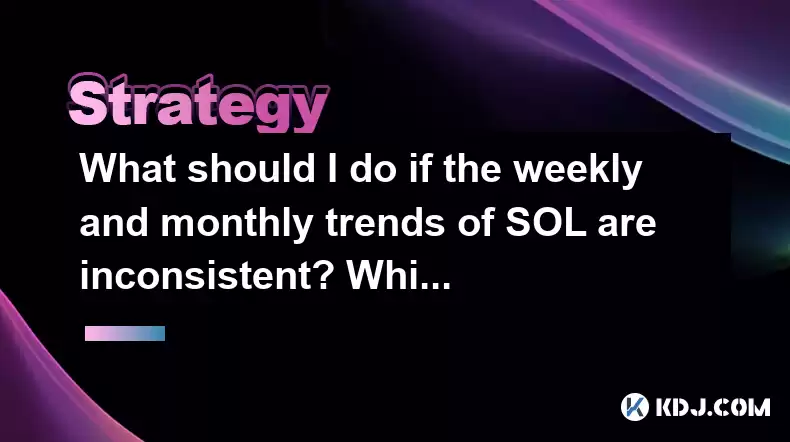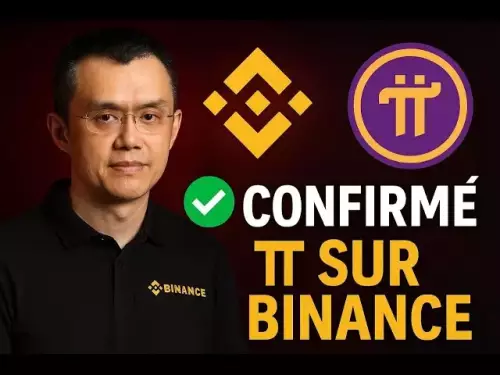-
 bitcoin
bitcoin $112715.707551 USD
-1.71% -
 ethereum
ethereum $4101.475385 USD
-3.01% -
 tether
tether $1.000644 USD
-0.02% -
 bnb
bnb $1207.619465 USD
-6.77% -
 xrp
xrp $2.501451 USD
-3.98% -
 solana
solana $202.947124 USD
-3.32% -
 usd-coin
usd-coin $1.000295 USD
0.04% -
 dogecoin
dogecoin $0.203884 USD
-4.47% -
 tron
tron $0.317154 USD
-1.72% -
 cardano
cardano $0.695009 USD
-4.43% -
 hyperliquid
hyperliquid $38.853961 USD
-8.23% -
 chainlink
chainlink $18.988674 USD
-4.64% -
 ethena-usde
ethena-usde $1.000233 USD
-0.03% -
 stellar
stellar $0.337050 USD
-3.63% -
 bitcoin-cash
bitcoin-cash $536.861728 USD
-1.28%
What should I do if the weekly and monthly trends of SOL are inconsistent? Which time period should I follow?
Analyzing both weekly and monthly trends of Solana (SOL) can help investors make informed decisions, balancing short-term volatility with long-term stability.
Apr 29, 2025 at 03:00 am

When dealing with the weekly and monthly trends of Solana (SOL) that appear inconsistent, it can be challenging to decide which time period to follow for making informed investment decisions. Understanding the nuances of these trends and knowing how to interpret them can significantly enhance your trading strategy. This article will guide you through the process of analyzing both weekly and monthly trends, helping you determine which time period might be more reliable for your investment decisions.
Understanding Weekly Trends
Weekly trends provide a shorter-term view of the market, often capturing more immediate reactions to news, events, and market sentiment. These trends can be more volatile but are useful for traders looking to capitalize on short-term movements. When analyzing weekly trends for SOL, you should:
- Look at the price action over the past few weeks to identify patterns such as support and resistance levels, trend lines, and potential breakouts.
- Consider the volume accompanying these price movements. High volume can confirm the strength of a trend, while low volume might indicate a lack of conviction.
- Monitor any significant news or developments related to Solana that might have influenced the weekly price movements.
By focusing on these aspects, you can gain insights into the immediate market dynamics affecting SOL.
Understanding Monthly Trends
Monthly trends, on the other hand, offer a longer-term perspective on the market, smoothing out short-term fluctuations and highlighting more sustained movements. These trends are particularly useful for investors looking to hold assets over extended periods. When analyzing monthly trends for SOL, you should:
- Examine the overall price direction over the past few months to understand the broader market trend. Is SOL in a bullish, bearish, or sideways trend?
- Analyze key technical indicators such as moving averages, MACD, and RSI on a monthly chart to gauge the strength and momentum of the trend.
- Consider fundamental factors such as network growth, adoption rates, and technological developments that might influence the long-term value of SOL.
Monthly trends can help you understand the bigger picture and make more informed decisions about long-term investments.
Comparing Weekly and Monthly Trends
When the weekly and monthly trends of SOL appear inconsistent, it's essential to compare them to understand the underlying dynamics. Here's how you can do it:
- Overlay the weekly and monthly charts to visually compare the trends. Look for divergences where the weekly trend might be moving in a different direction than the monthly trend.
- Identify the reasons behind these divergences. For instance, a positive weekly trend might be driven by short-term news, while a negative monthly trend could be influenced by broader market conditions or long-term fundamentals.
- Assess the strength of each trend. A strong monthly trend might outweigh a weaker weekly trend, suggesting that the longer-term direction is more reliable.
By comparing these trends, you can better understand which one might be more indicative of SOL's future price movements.
Which Time Period Should You Follow?
Deciding which time period to follow depends on your investment goals and risk tolerance. Here are some considerations to help you make this decision:
- If you are a short-term trader, you might prioritize weekly trends. These trends can provide more immediate opportunities for profit, but they come with higher volatility and risk.
- If you are a long-term investor, monthly trends might be more suitable. These trends can help you make more informed decisions about holding SOL for an extended period, potentially leading to more stable returns.
- Consider your risk tolerance. If you can handle more volatility, weekly trends might be more appealing. If you prefer a more stable investment approach, monthly trends could be more appropriate.
Ultimately, the choice between weekly and monthly trends depends on your individual investment strategy and goals.
Using Both Trends for a Balanced Approach
Rather than choosing one over the other, you can use both weekly and monthly trends to create a more balanced and informed investment strategy. Here's how:
- Use monthly trends to establish your overall investment thesis and long-term strategy. This can help you decide whether to hold SOL for an extended period.
- Use weekly trends to fine-tune your entry and exit points. This can help you optimize your trades within the context of the longer-term trend.
By combining insights from both time periods, you can create a more robust trading strategy that leverages the strengths of each trend.
Practical Example: Analyzing SOL Trends
To illustrate how you can apply these concepts, let's walk through a practical example of analyzing SOL's weekly and monthly trends:
- Step 1: Gather Data
- Collect the weekly and monthly price data for SOL over the past year. You can use platforms like TradingView or CoinGecko to access this data.
- Step 2: Analyze Weekly Trends
- Plot the weekly price chart and identify key support and resistance levels.
- Look for patterns such as head and shoulders, double tops, or trend line breaks.
- Check the volume to confirm the strength of any identified trends.
- Step 3: Analyze Monthly Trends
- Plot the monthly price chart and identify the overall trend direction.
- Use technical indicators like the 50-month and 200-month moving averages to gauge the trend's strength.
- Consider any significant fundamental developments that might have influenced the monthly trend.
- Step 4: Compare Trends
- Overlay the weekly and monthly charts to identify any divergences.
- Analyze the reasons behind these divergences, such as short-term news versus long-term fundamentals.
- Assess the strength of each trend to determine which one might be more reliable.
- Step 5: Make a Decision
- Based on your investment goals and risk tolerance, decide whether to follow the weekly, monthly, or a combination of both trends.
- If you're a short-term trader, you might focus on the weekly trends for entry and exit points.
- If you're a long-term investor, you might prioritize the monthly trends for your overall investment strategy.
By following these steps, you can make more informed decisions about SOL based on its weekly and monthly trends.
Frequently Asked Questions
Q1: Can I use daily trends in addition to weekly and monthly trends for analyzing SOL?Yes, daily trends can provide even more granular insights into SOL's price movements. They are particularly useful for day traders looking to capitalize on intraday volatility. However, daily trends should be used in conjunction with weekly and monthly trends to get a comprehensive view of the market.
Q2: How can I use technical indicators to confirm trends in SOL?Technical indicators such as moving averages, RSI, and MACD can help confirm trends in SOL. For instance, if the price of SOL is above its 50-week moving average and the RSI is above 50, it might indicate a strong bullish trend. Conversely, if the price is below the 200-month moving average and the MACD is showing bearish divergence, it might suggest a bearish trend.
Q3: What role do fundamental factors play in analyzing SOL's trends?Fundamental factors such as network growth, adoption rates, and technological developments can significantly influence SOL's long-term trends. For instance, if Solana's network is experiencing rapid growth and adoption, it might support a bullish monthly trend. Conversely, if there are concerns about the network's scalability or security, it might contribute to a bearish trend.
Q4: How can I stay updated on the latest news and developments affecting SOL's trends?To stay updated on the latest news and developments affecting SOL, you can follow reputable cryptocurrency news sources such as CoinDesk, CoinTelegraph, and CryptoSlate. Additionally, joining Solana's official social media channels and community forums can provide real-time updates and insights from other investors and developers.
Disclaimer:info@kdj.com
The information provided is not trading advice. kdj.com does not assume any responsibility for any investments made based on the information provided in this article. Cryptocurrencies are highly volatile and it is highly recommended that you invest with caution after thorough research!
If you believe that the content used on this website infringes your copyright, please contact us immediately (info@kdj.com) and we will delete it promptly.
- Zero Knowledge Proof, Whitelist, Blockchain 2025: The Dawn of Private, Scalable Infrastructure
- 2025-10-16 01:20:01
- Altcoins, Whales, and Tariff Threats: Navigating the Crypto Seas
- 2025-10-16 01:20:01
- ChatGPT's Crystal Ball: HBAR Price Prediction and the Rise of Snorter in 2025
- 2025-10-16 01:20:01
- ZEROBASE Listing and Airdrop: A New Era for ZK Tech?
- 2025-10-16 00:25:13
- Digital Euro, Gold Standard, and Active Reserves: A New York Minute on the Future of Money
- 2025-10-16 00:25:13
- TCG OTS Pack Spoilers: What's Hot and What's Not?
- 2025-10-16 00:33:47
Related knowledge

Practical parameter settings for a Bitcoin multi-timeframe moving average system
Sep 18,2025 at 10:54pm
Optimizing Timeframe Combinations for Bitcoin Trading1. Selecting appropriate timeframes is crucial when building a multi-timeframe moving average sys...

How can I filter out false breakouts in Dogecoin high-frequency trading?
Sep 22,2025 at 01:00am
Understanding False Breakouts in Dogecoin Trading1. A false breakout occurs when Dogecoin's price appears to move beyond a defined support or resistan...

Techniques for identifying tops and bottoms in the Bitcoin on-chain NVT model
Sep 20,2025 at 07:54pm
Understanding the NVT Model in Bitcoin Analysis1. The Network Value to Transactions (NVT) ratio is often described as the 'P/E ratio' of the cryptocur...

What does the surge in open interest in Bitcoincoin futures mean?
Sep 20,2025 at 11:18pm
Understanding the Surge in Dogecoin Futures Open Interest1. A surge in open interest within Dogecoin futures indicates a growing number of active cont...

How can I use the Ethereum USDT premium to gauge market sentiment?
Sep 18,2025 at 11:55pm
Understanding the Ethereum USDT Premium1. The Ethereum USDT premium refers to the price difference between USDT (Tether) traded on Ethereum-based plat...

What should I do if Ethereum staking yields decline?
Sep 20,2025 at 06:18am
Understanding the Causes Behind Declining Ethereum Staking Yields1. The Ethereum network transitioned to a proof-of-stake consensus mechanism with the...

Practical parameter settings for a Bitcoin multi-timeframe moving average system
Sep 18,2025 at 10:54pm
Optimizing Timeframe Combinations for Bitcoin Trading1. Selecting appropriate timeframes is crucial when building a multi-timeframe moving average sys...

How can I filter out false breakouts in Dogecoin high-frequency trading?
Sep 22,2025 at 01:00am
Understanding False Breakouts in Dogecoin Trading1. A false breakout occurs when Dogecoin's price appears to move beyond a defined support or resistan...

Techniques for identifying tops and bottoms in the Bitcoin on-chain NVT model
Sep 20,2025 at 07:54pm
Understanding the NVT Model in Bitcoin Analysis1. The Network Value to Transactions (NVT) ratio is often described as the 'P/E ratio' of the cryptocur...

What does the surge in open interest in Bitcoincoin futures mean?
Sep 20,2025 at 11:18pm
Understanding the Surge in Dogecoin Futures Open Interest1. A surge in open interest within Dogecoin futures indicates a growing number of active cont...

How can I use the Ethereum USDT premium to gauge market sentiment?
Sep 18,2025 at 11:55pm
Understanding the Ethereum USDT Premium1. The Ethereum USDT premium refers to the price difference between USDT (Tether) traded on Ethereum-based plat...

What should I do if Ethereum staking yields decline?
Sep 20,2025 at 06:18am
Understanding the Causes Behind Declining Ethereum Staking Yields1. The Ethereum network transitioned to a proof-of-stake consensus mechanism with the...
See all articles










































































